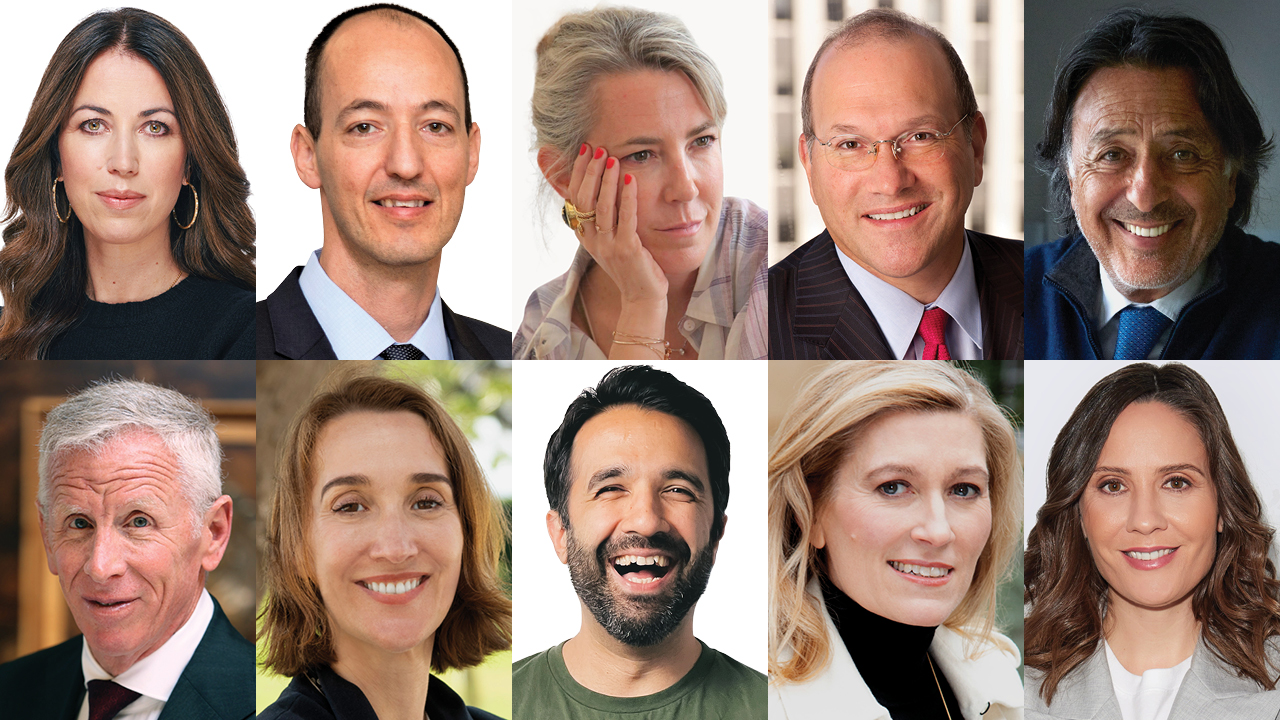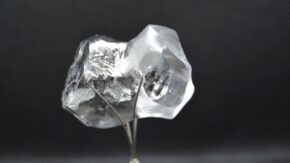We recognize that you can’t recover nature’s treasures without treasuring nature. This is why we are doing everything we can for a better, more sustainable future. Our sustainability framework, Building Forever, sits at the heart of everything we do, from our diamond recovery operations in Botswana, Canada, Namibia and South Africa, through to the stores where we sell our diamond jewelry. It guides our work, our decisions and our behaviors.
Three years ago, we set out 12 goals that we are determined to achieve by 2030. These goals include being carbon-neutral across our operations, providing the origin and impact of every diamond we discover and sell, and supporting 10,000 women entrepreneurs and 10,000 women and girls in science, technology, engineering and mathematics (STEM).
Our commitment means that every one of our diamonds can be worn with pride.
Celine Assimon
CEO, De Beers Jewellers and De Beers ForevermarkSustainability is crucial for our world’s future. At Sarine, as technologists and scientists, we play a vital role in enabling and driving sustainable practices through technology. Reliable, data-based traceability, from raw material to final product and onward in the secondary market, is a core enabler for sustainability.
Our expertise in technology and data analytics delivers verifiable and dependable tracking solutions for the entire life cycle of diamond jewelry. We empower stakeholders to make informed decisions, thereby ensuring responsible practices throughout the supply chain.
With a passionate belief in a sustainable future and the transformative power of data-driven traceability, we strive to enable ethical sourcing and environmental impact reduction, all in alignment with our commitment to a sustainable world.
David Block
CEO, Sarine TechnologiesSustainability encompasses a long-term perspective that considers the well-being of future generations and the responsibility we hold now in protecting our people and planet transparently. At Dimexon, it means building trust and confidence through responsible business practices and concrete actions that prioritize social and environmental stewardship.
For decades, sustainability has been at the heart of Dimexon’s operations, and today it is fully integrated into our business strategy and communication. We believe transparency is key — in our supply chain, but also promoting open communication and accountability in decision-making processes.
We strive to create a world where progress is not achieved at the expense of our planet, resources and human beings. It also involves nurturing a harmonious relationship with our ecosystems, and in this field, partnerships are instrumental.
Morgane Winterholer
General Manager of Strategic Brands and Sustainability, DimexonAs the leading trade association in the US, Jewelers of America’s mission is to improve consumer confidence in fine jewelry and watches. All of Jewelers of America’s members must commit annually to our Code of Professional Practices, and many aspects of the code relate to sustainability.
Additionally, we provide guidance on the most important issues jewelers face. That guidance has a direct impact on the sustainability of jewelers’ commercial business.
Examples of guidance and best practices include responsible sourcing of diamonds, gemstones, gold and other precious metals, as well as in-depth business guidance. Jewelers of America is a valuable resource to help insure jewelers’ long-term sustainability.
David Bonaparte
President and CEO, Jewelers of AmericaEven [when I was] growing up as a boy, we were always aware of consumption and respect for the planet. When I fell in love with diamonds, I wanted to find ways to embed that philosophy into the business, using a combination of innovation, technology and disclosure to my customers.
As a certified member of the Responsible Jewellery Council, and Cartier and Kering’s Watch & Jewellery Initiative 2030, we at Andre Messika Diamonds have intensified our commitment to recognized sustainability-focused frameworks and our priorities include ethical sourcing and accurate traceability, in addition to decarbonizing operations, such as our Namibian cutting factory.
Needless to say, the social aspect is key, and our disabled and hard-of-hearing workforce in Namibia clearly demonstrates our commitment to society.
Andre Messika
Founder and Chairman, Andre Messika DiamondsAs today’s consumer seeks sustainability in every aspect of their lives, we have developed a program at CD Peacock to reduce the industry’s environmental impact by elevating the traditional estate-sale model, which has always been a means to recycle jewelry.
By retooling our jewelry repair centers into jewelry workshops, we not only repair jewelry as a service to our clients, but have developed a creative space for bench jewelers and jewelry designers to reimagine vintage jewelry acquired throughout the year.
During CD Peacock’s biannual estate sales, clients find not only pre-owned jewelry refurbished to perfection, but unique pieces with modern appeal created by our in-house artisans from vintage parts.
Steven Holtzman
Vice Chairman, CD PeacockAs a leader in the gem and jewelry industry, GIA upholds the highest standards of integrity, academics and science in everything we do, including sustainability. Our sustainability initiatives strive to build an inclusive and resilient future for people and the planet through social inclusion, environmental protection and economic growth.
GIA’s first environmental, social and governance (ESG) report is now available and we will share yearly updates. Other recent initiatives include GIA’s participation in Tracr, which provides GIA grading reports with information about the diamond’s origin, allowing full transparency on the diamond journey to the consumer.
By working together as an industry to champion transparency and traceability and build trust, we will spark real, sector-wide sustainable change.
Johanna Levy
Vice President of ESG Programs, GIASustainability for us is connected to both the environmental and human impacts within our supply chain, and is a goal that we are striving toward with our diamond- and sapphire-sourcing practices. It is also a term that we do not use lightly.
Both industries have much work to do before the words ‘ethical’ and ‘sustainable’ can be used, and our mindfulness regarding the use of those terms is because we believe that while progress has been made in our sourcing channels and within our industry, it does not serve us, our clients or the cause to greenwash the supply chain with rosy terms for marketing purposes.
Ashkan Asgari
Founder and CEO, Misfit DiamondsAt Kering, we are very ambitious when it comes to sustainability, and we set the framework for our houses, including our jewelry houses. This includes our Kering Standards, which act as a guide for best practices across raw materials — including diamonds — and manufacturing.
We have also committed to a series of targets. As an example, our target to reduce 40% of the group’s absolute emissions across scopes 1, 2 and 3 by 2035 is driving our houses forward. For jewelry, this means sustainable sourcing for diamonds and precious stones, recycled and ethical precious metals, and innovative design combined with cutting-edge technologies.
Collaboration is also key, which is why Kering established the Watch & Jewellery Initiative 2030 with Cartier to bring together the sector for collective action.
Marie-Claire Daveu
Chief Sustainability and Institutional Affairs Officer, KeringAs a business that specializes in pre-loved luxury items, sustainability is at the heart of what we do. Our company slogan is, in fact, ‘Proud to be pre-loved.’ By focusing on pre-owned jewelry, we’re actively promoting and supporting the circular economy, which drives down all the environmental impacts associated with processing new fine jewelry.
I’m also actively looking to source jewelry from wholesalers who use recycled gold or repurposed gemstones. I wish this were more commonplace in the supply chain, but I feel we are getting closer every month.
I would actually love to see a hallmark specifically for recycled gold so that retailers of secondhand pieces could continue to promote that highlight, which final end-users are seeing more and more as an asset to their jewelry.
Sarah Duncan
Head of Fine Jewelry, Luxury PromiseMain image: top row (left to right) Celine Assimon, De Beers; David Block, Sarine Technologies; Morgane Winterholer, Dimexon; David Bonaparte, Jewelers of America; Andre Messika, Andre Messika Diamonds; bottom row (left to right) Steven Holtzman, CD Peacock; Johanna Levy, Gemological institute of America (GIA); Ashkan Asgari, Misfit; Marie-Claire Daveu, Kering; Sarah Duncan, Luxury Promise.
This article is from GIA’s Spotlight on Sustainability special report. View other articles here.
Stay up to date by signing up for our diamond and jewelry industry news and analysis.




